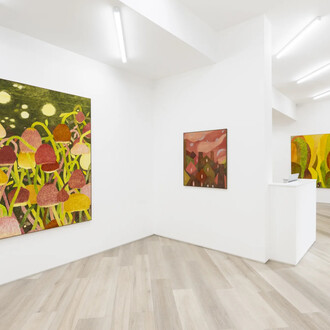For Leonardo Ulian’s first solo exhibition with Beers.Lambert, the artist has created his most intensive and mesmerizing series of works to date; entitled Sacred Space, the exhibition consists of a series of mandalas, a symbol from Hindu and Buddhist symbolism that represents metaphysical enlightenment, made entirely from meticulously arranged electronic components. Ulian's reflexive use of the geometrical mandala can also be seen as a nod to his 'past-life' as an technican, but through his application, Ulian divorces the electronic components from their origins, giving new life to these (now defunct) technological bits, creating a new type of hybridization that is equal parts spiritualization and contemporary critique: “We live in a society that worships electronic technology,” he states “both for necessity but also because it makes us feel better, not unlike its own new form of fashionable spirituality.”
His interest in the technological mandala began when considering the relationship between modern day human nature and pursuits of personal fulfillment, to the 'cult of the electronic', including our perception of Eastern spiritualization as 'Enlightened', and the dependency placed upon the technological as a modern day savior. Perhaps he comments on the realization that Western cultures (abundant with technology, industrialization, commercial progress, and the pursuit of acquiring material belongings) are consistently ranked as the least happy cultures worldwide. Those cultures that project their spiritualization upon symbolism and belief in self reflection and convalescence, however, are more fulfilled, and happier.
But Ulian's use is not an outright critique of our society. For there is joy in these mandalas, a colorful circuitousness of shape, form, and function(lessness). Furthermore, the mandalas reference processes of causality and creation. Through their use, Ulian points to what has been hidden from the eyes of the consumer, representing technology as extraordinary, even sublime or theological, where perfection, design, and meditation are united. "The technological mandalas are an external representation of an ideal organization of geometric shapes and ideal journey of the mind." In this sense, these up-cycled works become something more than the sum of their parts; they become something almost ethereal. In stark contrast to how meaning is often generated today: through mass production and sheer inundation of image and message, here is a clear and unaltered form of personal and spiritual communication.
Indeed, if the experience for the viewer is meditative; it is certainly an act of devotion for Ulian. Through his arduous, unmistakably (and crucially) handmade process, electronic components lose any past functionality in order to become reincarnated, passive components; but reflective of their own past lives, each is imperative to the reading of the whole. For each on its own may appear insignificant, but in its current incarnation (as well as its previous life on a circuit board) each is paramount for information, communication, relay, and autonomy. The mandalas present us with meaning by way of the meaningless, thought by way of the thoughtless; that is to say, as viewers, we project our own peace upon these forms, we extract from them the very meaning we want to extract, however simplistic and symmetric....or however complex and profound.
Through these harmonic shapes, Ulian claims that his very purpose is to "generate inner images actively through the minds of the viewers who are looking into the physical pieces hanged on the wall." Ideally, the energy that flows through his mandalas circuits is a current of thoughts, possible questions and inner feelings reflecting the human condition in this specific moment in history. It seems the universe Ulian creates is a utopian cross section between the technological, spirtual, and corporeal: an infinite connection among persons, objects or places, like the countless routes and connections found spinning out from the centre of the mandala, awash with all its complexities and intricacies, both small and large, mundane and inspired.
Leonardo Ulian (b.1974) has had solo-exhibitions including Time Wave Zero, Gallery Espacio Valverde, Madrid, Spain (2012); Flames, Roses, and Wires, Shaft Gallery, London (2010), and Iperuranio, Kobo Art Space, Udine, Italy (2009). Selected group exhibitions include: Motion 1, Syzygy Art Space, London (2012); Bow Art Open, Bermondsey Project Space, London (2012); Condensation, Immaginare il Tempo, Clauiano, Italy (2011); Umlaut, Hales Gallery, London (2009); Three by Three (IV), Yinka Shonibare Project Space at Sunbury House, London (2009). Ulian was also awarded the Owne Rowley Award in London (2009), as well as the Stamps of the XX Century (national prize) in Udine, Italy (2000). Ulian will be exhibiting with Beers.Lambert at the London Art Fair in January 2013. He has been collected by the fashion house Hermès of Paris International, Fidelity Worldwide Investments, Hobby Lemon collection, and a number of prestigious private collections internationally. His work has also been commissioned by Wired magazine and for Hermès' flagship store in Paris. He holds a Bachelor of Fine Art from Sir John Cass Faculty of Art, Certification in Graphic and Multimedia Design from the Graphic Art Centre in Udine, Italy, as well as a Diploma in Technical Micro-electronics from the Institute of Industry and Handicrafts in Gorizia, Italy. He lives and works in London, UK.



















